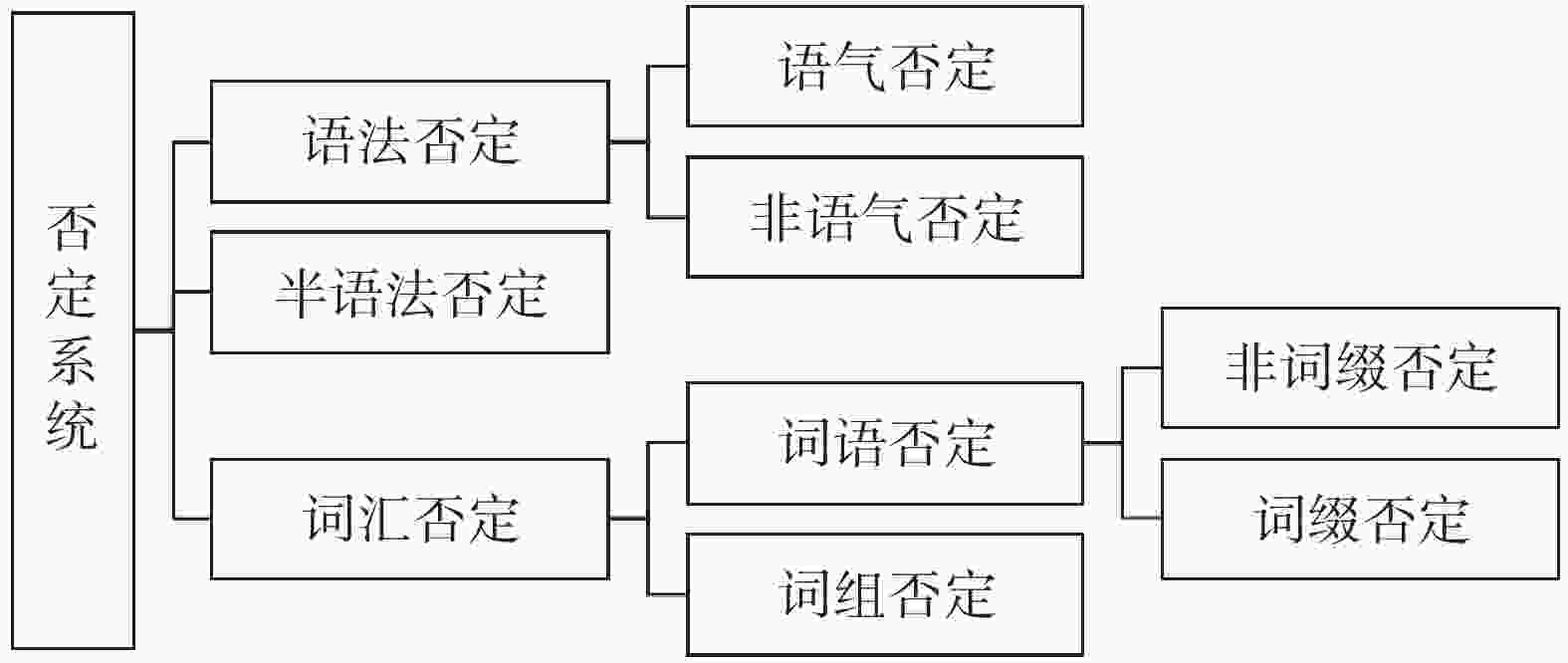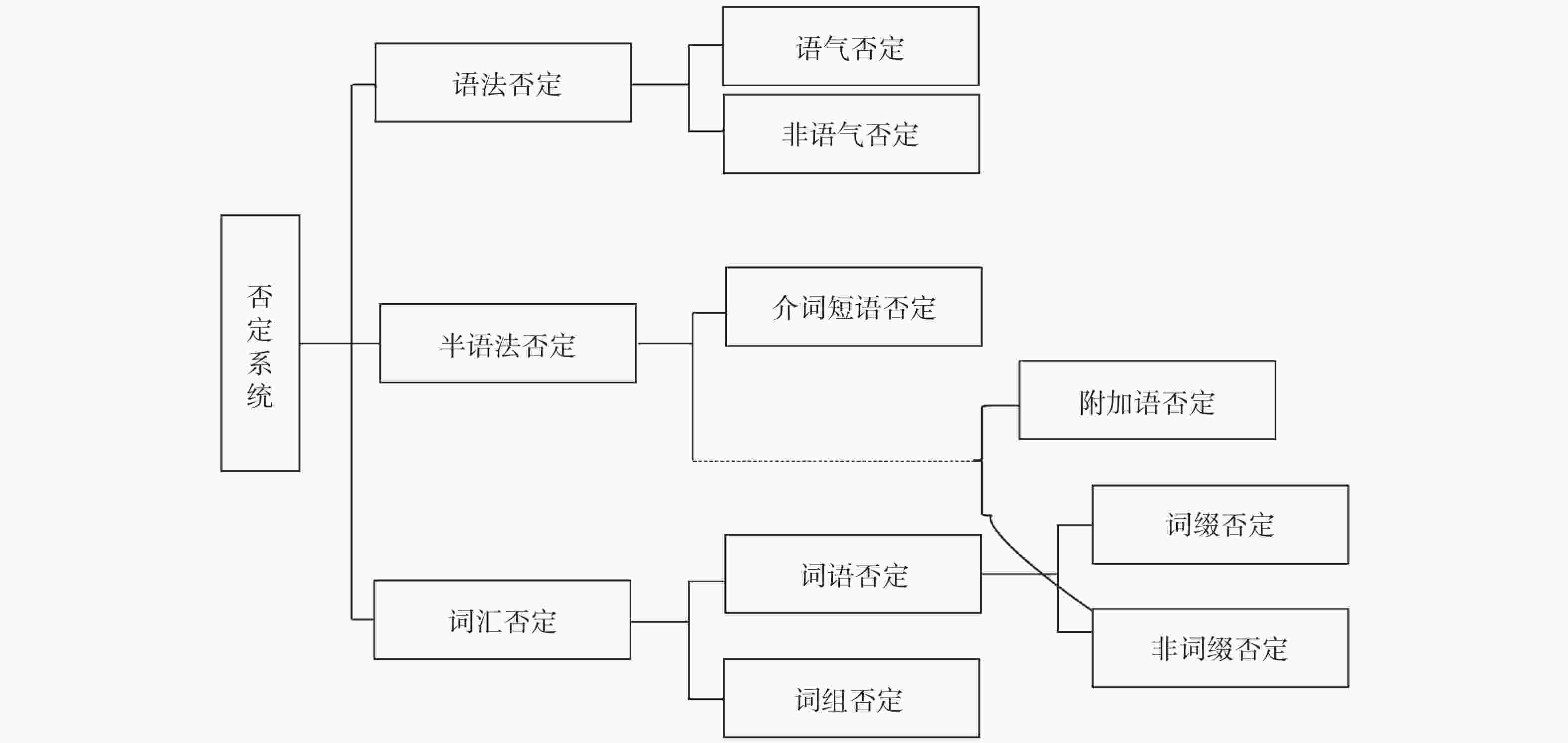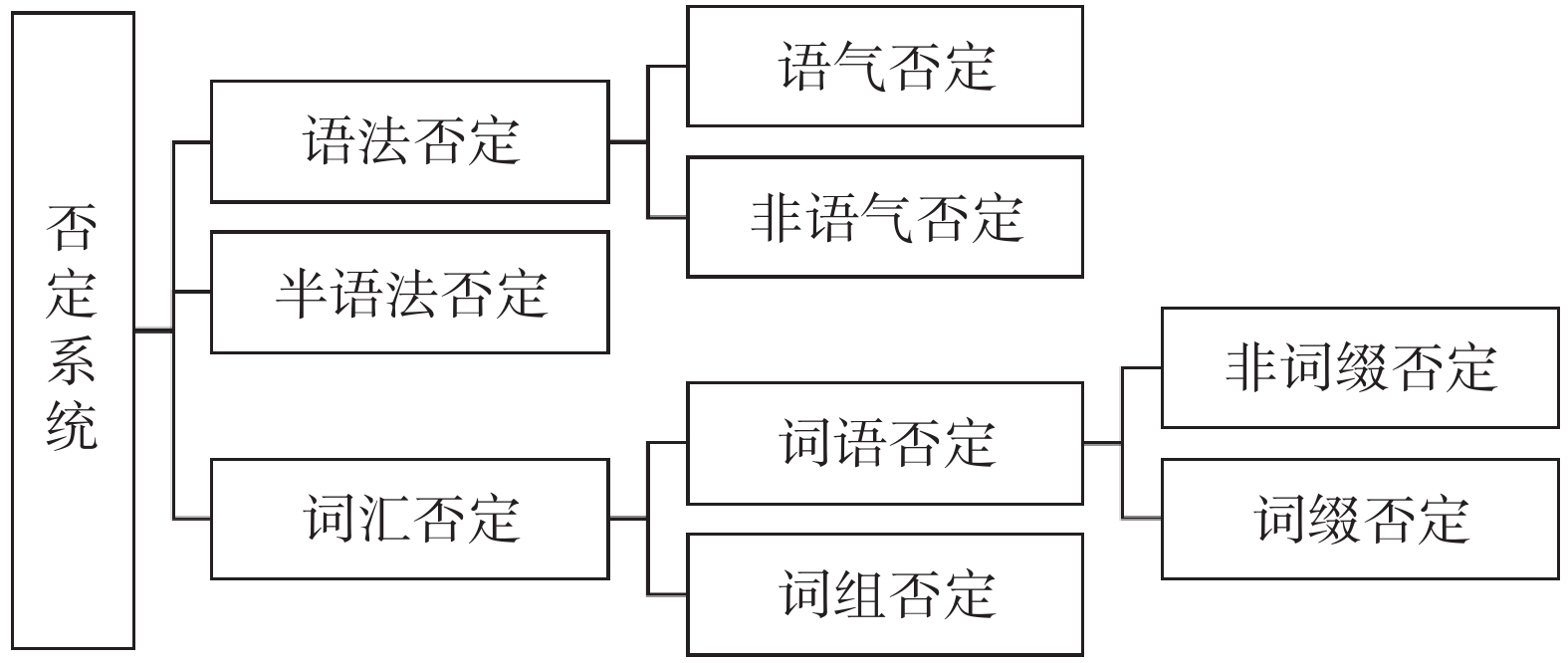A Logogenetic Study of Negative Polarity in English Academic Discourse: A SFL Perspective
-
摘要: 文章在系统功能语言学框架内,采用语料库辅助的研究方法,以英国学术英语写作语料库(BAWE)和学术口语语料库(BASE)为语料,探讨英语否定极性的学术语篇发生特征。否定极性系统包含语法、半语法和词汇三种类型,其中词汇否定系统的子类型在书面语篇中发生的频次显著多于口语语篇,体现三重复合功能;而语法否定中的语气否定、半语法否定中的介词短语否定以及附加语否定在书面语篇中发生的频次则要显著少于口语语篇,体现单重或双重复合功能。否定极性类型总体呈现级阶上升、功能潜势单一化的倾向特征。英语否定极性系统的学术语篇发生特征是小句功能潜势的语法挤压所致。否定极性语法化、词汇化的不同发生潜势厘定有助于学习者学术话语交际的否定适用选择。Abstract: Based on Systemic Functional Linguistics, taking a corpus-assisted approach, this study explores the logogenetic characteristics of negative polarity in English by adopting British Academic Written English (BAWE) and British Academic Spoken English (BASE) as corpus. The study finds that lexical negation in English written texts is significantly higher in frequency than that in spoken texts, realizing triple meta-functions; while mood negation, phrasal negation and adjunct group negation in written texts are significantly lower compared with spoken texts, realizing single or double meta-functions, which shows a discursive trend that meta-function realization by negative polarity becomes more simplified with the upgrade of clausal rank-scale. The study shows that the logogenetic characteristic of negative polarity system in English academic discourse could be attributed to the grammatical condensing in academic discourse. The different logogenetic potential of grammaticalization and lexicalization in negative polarity is conducive to the appliable choice of negative choice on the part of English learners in academic communication.
-
Key words:
- negation /
- grammatical negation /
- lexical negation /
- SFL /
- logogenesis
-

图 1 语言中的否定系统[48]

图 2 英语的否定系统再扩展

图 3 否定极性的语篇发生
表 1 学术语篇语料库信息
语料库 样本量 形符/字 类符/字 BAWE 2457篇 7073151 87496 BASE 203篇 1738289 31015 BAWE-1 10000行 289823 22559 BASE-1 10000行 309291 13834 表 2 否定极性发生频次前10
类型 语法否定 半语法否定 词汇否定 语气否定 非语气否定 介词短语否定 附加语否定 词组否定 非词缀否定 词缀否定 BAWE-1 is not 595 not to 89 beyond 78 never 138 no+ N. 750 reduce 338 un- 1335 does not 367 not+ Ving 80 instead of 58 rarely 33 prevent from 33 little 304 in- 617 are not 238 not+ Ved 21 without 29 little 16 break down 28 loss 174 non- 292 do not 227 too...to 27 hardly 14 protect from 10 avoid 121 im- 206 was not 221 neither...nor 20 barely 11 devoid of 9 fail 115 mis- 172 did not 215 by no means 16 seldom 8 free from 8 decrease 101 less 135 were not 111 in no way 10 remove from 7 damage 93 ir- 93 may not 107 for fear for 5 lack of 6 remove 92 anti- 57 will not 96 in vain 2 give up 6 failure 84 dis- 45 would not 93 instead 2 escape from 4 lack 59 il- 27 BASE-1 don’t 1620 not to 79 without 183 never 211 no+ N. 586 failure 123 un- 544 doesn’t 561 not+ Ving 64 instead of 63 hardly 17 get rid of 37 lose 99 in- 188 can’t 530 not+ Ved 13 beyond 59 rarely 12 give up 21 little 90 non- 162 didn’t 436 at a loss 4 little 3 short of 13 loss 90 mis 83 isn’t 367 by no means 3 scarcely 3 break down 11 die 86 less 60 is not 329 in no way 2 seldom 2 given up 8 reduce 85 im- 53 haven’t 211 too... to 2 barely 1 end up 6 fail 77 anti- 43 wouldn’t 185 by no sense 1 getting rid of 5 lack 56 ir- 39 won’t 174 for fear for 1 protect from 5 remove 51 ab- 25 wasn’t 168 not at all 1 cut down 4 damage 49 non- 19 表 3 否定极性类型的语篇发生频次差异
类型 BAWE-1 BASE-1 频数差异(Chi-square test) 语气否定 2880 5889 −3009*** 非语气否定 190 156 34 介词短语否定 251 321 −70*** 附加语否定 220 249 −29* 词组否定 879 718 161** 非词缀否定 2478 1345 1133*** 词缀否定 3084 1261 1823*** 注:*p<0.05;**p<0.01;***p<0.001 -
[1] JORDAN M P. The power of negation in English:text,context and relevance [J]. Journal of Pragmatics, 1998, 29(6):705-752. doi: 10.1016/S0378-2166(97)00086-6 [2] 克里斯特尔·戴维. 现代语言学词典[Z], 沈家煊, 译. 北京: 商务印书馆, 2000. [3] HALLIDAY M A K. Corpus studies and probabilistic grammar [C] // WEBSTER J. Computational and Quantitative Studies: Vol. 6 in The Collected Works of M. A. K. Halliday. London: Continuum, 1991: 63-76. [4] HALLIDAY M A K & MATTHIESSEN C M I M. An Introduction to Functional Grammar [M]. London: Routledge, 2014. [5] LAKOFF G. Pronominalization and the analysis of adverbs of negation [C]// RODERICK J & PETER R. Readings in English Transformation Grammar. Massachusetts: Ginn and Company, Waltham, 1970: 146-165. [6] HORN L R. Metalinguistic negation and pragmatic ambiguity [J]. Language, 1985, 61:121-174. doi: 10.2307/413423 [7] 孔庆成. 元语否定的类型[J]. 外国语(上海外国语大学学报),1995(4):11-16. [8] CARSTON R. Metalinguistic negation and echoic use [J]. Journal of pragmatics, 1996, 25(3):309-330. doi: 10.1016/0378-2166(94)00109-X [9] 何春燕. 语用否定的类型及使用动机[J]. 解放军外国语学院学报,2002(3):20-24,53. doi: 10.3969/j.issn.1002-722X.2002.03.005 [10] 梁晓波. 否定的认知分析[J]. 外语研究,2004(5):12-18,80. doi: 10.3969/j.issn.1005-7242.2004.05.003 [11] 杨先顺. 语用否定的逻辑分析[J]. 自然辩证法研究,2005(1):28-32. doi: 10.3969/j.issn.1000-8934.2005.01.008 [12] STÉPHANIE B. Lexical negation in English:the case of un- and in- [J]. Interlingüística, 2010, 20:1-9. [13] HAVIGEROVA J M & KARASKOVA H. Lexical negation in Czech initial education–negative imperatives from the teacher’s mouth [J]. Procedia-Social and Behavioral Sciences, 2012, 69:428-434. doi: 10.1016/j.sbspro.2012.11.430 [14] ANDREOU M. Lexical negation in lexical semantics:the prefixes in-and dis [J]. Morphology, 2015, 25(4):391-410. doi: 10.1007/s11525-015-9266-z [15] SINGERMAN A R. Negation as an exclusively nominal category [J]. Language, 2018, 94(2):432-467. doi: 10.1353/lan.2018.0022 [16] LARRIVÉE P. Metalinguistic negation from an informational perspective [J]. Glossa:A Journal of General Linguistics, 2018, 3(1):1-22. [17] LARRIVÉE P. Turning negative:micro-steps from negative polarity item to negative-word [J]. Language Sciences, 2021, 85:1-14. [18] PAGANO A S. A Pragmatic Study of Negatives in Written Text [D]. Brazil: Federal University of Santacatarina, 1991. [19] WÄLCHLI B. The morphologization of negation constructions in Nalca (Mek,Tanah Papua),or,how nothing easily moves to the middle of a word [J]. Linguistics, 2018, 56(6):1413-1461. doi: 10.1515/ling-2018-0027 [20] CABLE S. The good,the ‘not good’,and the ‘not pretty’:negation in the negative predicates of Tlingit [J]. Natural Language Semantics, 2018, 26(3):281-335. [21] FRAZIER L,CLIFTON JR C,RICH S,et al. Anticipating negation:the Dos and Don’ts of Neg raising [J]. Syntax, 2018, 21(2):160-194. doi: 10.1111/synt.12151 [22] LI F,BORRÀS-COMES J & ESPINAL M T. Single negation interpretations in sentences with multiple negative expressions in Mandarin Chinese:an experimental investigation [J]. Lingua, 2018, 210:65-78. [23] LASNIK H. On the semantics of negation [C]// DAVID H, WILLAM H & BRIAN F. Contemporary Research in Philosophical Logic and Linguistic Semantics. Dordrecht: Springer, 1975: 279-313. [24] HORN L R. A Natural History of Negation [M]. Chicago: The University of Chicago Press, 1989. [25] 戴耀晶. 试论现代汉语的否定范畴[J]. 语言教学与研究,2000(3):45-49. [26] 胡建华. 否定、焦点与辖域[J]. 中国语文,2007(2):99-112,191. [27] 苗兴伟. 否定结构的语篇功能[J]. 外语教学与研究,2011,43(2):220-229,320. [28] SMITH S. B. Meaning and Negation [M]. Berlin: De Gruyter Mouton, 2015. [29] DUZI, M. Presuppositions and two kinds of negation [J]. Logique et Analyse, 2017, 239:245-263. [30] WODE H. Four early stages in the development of LI negation [J]. Journal of Child Language, 1977, 4(1):87-102. doi: 10.1017/S0305000900000490 [31] 于善志,张新红. 从独词句和否定句看标记与习得序列[J]. 现代外语,1999(4):382-396. [32] 于善志. 否定标示的词汇特征和否定句习得序列[J]. 外语与外语教学,2002(8):17-19, 23. doi: 10.3969/j.issn.1004-6038.2002.08.005 [33] 于善志. 从句法研究看L2英语否定句习得[J]. 天津外国语学院学报,2013(1):21-25. [34] 苏冰. 第二语言习得中的学习顺序[J]. 山东外语教学,2005(1):74-75. doi: 10.3969/j.issn.1002-2643.2005.01.021 [35] 贾光茂. 中国英语学习者对否定句中全称量词辖域的解读[J]. 现代外语,2018,41(3):377-388. [36] REUTER T,FEIMAN R & SNEDEKER J. Getting to no:pragmatic and semantic factors in two-and three-year-olds’ understanding of negation [J]. Child Development, 2018, 89(4):e364-e381. doi: 10.1111/cdev.12858 [37] 于中根. 中国英语学习者英语否定句磨蚀的回归和阈值假说实证研究[J]. 外语教学,2014,35(1):59-63. doi: 10.16362/j.cnki.cn61-1023/h.2014.01.022 [38] WANG J & CHAN Y H C. A feature-based approach to the acquisition of L2 Chinese negation by L1-English and L1-Korean learners [J]. Lingua, 2021, 252:1-23. [39] BIBER D. Variation across Speech and Writing [M]. London: Cambridge University Press, 1991. [40] TOTTIE G. Negation in English Speech and Writing: A Study in Variation [M]. San Diego: Academic Press, 1991. [41] TOTTIE G. Affixal and non-affixal negation-a case of stable variation over time? [C]// VAN OSTADE I T B, TOTTIE G & VAN DER WURFF W. Negation in the history of English. Berlin: De Gruyter Mouton, 2011: 233-268. [42] MARTÍNEZ I M P. Notes on the use and meaning of negation in contemporary written English [J]. Atlantis, 1995, 17(1-2):207-227. [43] BIBER D, JOHANSSON S & LEECH G. Spoken and Written English [M]. London: Edinburgh Gate: Person Education Limited, 1991. [44] VAN OSTADE I T B, TOTTIE G & VAN DER WURFF W. Negation in the History of English [M]. Berlin: De Gruyter Mouton, 1999. [45] 陈桦. 英语专业学生口语中的否定表达的韵律特征−一项基于SECCL的研究[J]. 解放军外国语学院学报,2005(2):46-51. doi: 10.3969/j.issn.1002-722X.2005.02.010 [46] 肖忠华,戴光荣. 英语中的否定:基于语料库的研究[J]. 外国语言文学,2009,26(4):228-236,288. doi: 10.3969/j.issn.1672-4720.2009.04.002 [47] HERRERO-ZORITA C. A statistical study of the usage of no-negation and not-negation in spoken academic English [J]. Procedia-Social and Behavioral Science, 2013, 95:482-489. doi: 10.1016/j.sbspro.2013.10.672 [48] 刘英. 否定系统与语类变体−一项基于英语学术语篇的否定概率研究[J]. 外语与外语教学,2013(1):27-30. doi: 10.13458/j.cnki.flatt.003871 [49] 张玉波,杨炳钧. 小句极性的元功能归属[J]. 外语教学与研究,2019,51(2):225-238,320. [50] HALLIDAY M A K & MATTHIESSEN C M I M. An Introduction to Functional Grammar [M]. London: Edward Arnold, 2004. [51] HALLIDAY M A K. Complementarities in Language [M]. Beijing: The Commercial Press, 2008. [52] BIBER D, JOHANSSON S, LEECH G, et al. Longman Grammar of Spoken and Written English [M]. Harlow: Pearson, 1999. [53] 贾培培,张敬源. 时态的功能研究[J]. 北京科技大学学报(社会科学版),2015,31(3):31-37. doi: 10.3969/j.issn.1008-2689.2015.03.005 [54] HALLIDAY M A K. Quantitative studies and probabilities in grammar [C]// WEBSTER J. Computational and Quantitative Studies: Vol. 6 in The Collected Works of M. A. K. Halliday. London: Continuum, 1993: 130-157. [55] QUIRK R, GREENBAUM S, LEECH G, et al. A Comprehensive Grammar of the English Language [M]. New York: Longman, 1985. [56] 庞雨甜,杨才英. 中外博士论文结论部分参与者导向词块情态特征对比研究[J]. 北京科技大学学报(社会科学版),2022,38(4):403-411. [57] 刘飞飞,常晨光. 报纸社论中作者−潜在受众联合关系话语建构策略−系统功能语言学个性化视角[J]. 北京科技大学学报(社会科学版),2022,38(1):44-50. [58] HALLIDAY M A K & MATTHIESSEN C. Construing Experience through Meaning: A Language-based Approach to Cognition [M]. London: Continuum, 1999. -




 下载:
下载:


